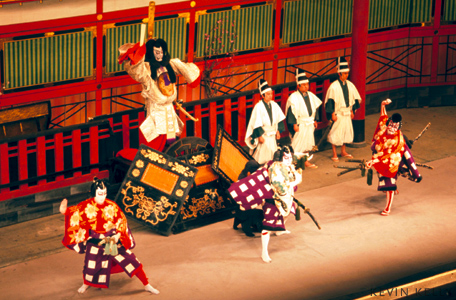Visual Arts
1. Painting ( Nihonga )
Painting has been an art in Japan for a very long time. It is one of the oldest and most highly refined of the Japanese arts, encompassing a wide variety of genre and styles. As with the history of Japanese arts in general, the history Japanese painting is a long history of synthesis and competition between native Japanese aesthetics and adaptation of imported ideas. The brush is a traditional writing tool, and the extension of that to its use as an artist's tool was probably natural. Japanese printmaking especially from the Edo period exerted enormous influence on Western painting in France during the 19th century.
2. Calligraphy ( Shodo )
The flowing, brush-drawn Japanese language lends itself to complicated calligraphy. Calligraphic art is often too esoteric for Western audiences and therefore general exposure is very limited. However in East Asian countries, the rendering of text itself is seen as a traditional art form as well as a means of conveying written information. The written work can consist of phrases, poems, stories, or even single characters. The style and format of the writing can mimic the subject matter, even to the point of texture and stroke speed. In some cases it can take over one hundred attempts to produce the desired effect of a single character but the process of creating the work is considered as much an art as the end product itself.
This art form is known as ‘Shodo’ which literally means ‘the way of writing or calligraphy’ or more commonly known as ‘Shuji’ ‘learning how to write characters’.
Commonly confused with Calligraphy is the art form known as ‘Sumi-e’ literally means ‘ink painting’ which is the art of painting a scene or object.
3. Sculpture ( Haniwa )
The sculpture of Japan started from the clay figure. Japanese sculpture received the influence of the Silk Road culture in the 5th century, and received a strong influence from Chinese sculpture afterward. The influence of the Western world was received since the Meiji era. The sculptures were made at local shops, used for sculpting and painting. Most sculptures were found at areas in front of houses and along walls of important buildings. Most of the Japanese sculptures derived from the idol worship in Buddhism or animistic rites of Shinto deity. In particular, sculpture among all the arts came to be most firmly centred on Buddhism. Materials traditionally used were metal—especially bronze—and, more commonly, wood, often lacquered, gilded, or brightly painted.
By the end of the Tokugawa period, such traditional sculpture - except for miniaturized works - had largely disappeared because of the loss of patronage by Buddhist temples and the nobility.
The oldest sculpture in Japan is a wooden statue of Amitābha at the Zenkō-ji temple. In the Nara period, Buddhist statues were made by the national government to boost its prestige. These examples are seen in present-day Nara and Kyoto, most notably a colossal bronze statue of the Buddha Vairocana in the Tōdai-ji temple.
Wood has traditionally been used as the chief material in Japan, along with the traditional Japanese architectures. Statues are often lacquered, gilded, or brightly painted, although there are little traces on the surfaces. Bronze and other metals are also used.
4. Flower Arranging ( Ikebana )
Ikebana is the Japanese art of flower arrangement. It has gained widespread international fame for its focus on harmony, colour use, rhythm, and elegantly simple design. It is an art centred greatly on expressing the seasons, and is meant to act as a symbol to something greater than the flower itself.
Traditionally, when third party marriages were more prominent and practiced in Japan, many Japanese women entering into a marriage learned to take up the art of Ikebana to be a more appealing and well-rounded lady. Today Ikebana is widely practiced in Japan, as well as around the world.
Performing Arts
1. Japanese Drama ( Noh & Kyogen )
The Noh drama is a blending of recitation, chants and ritual dancing focusing on Buddhist themes or concepts in which a ’moral or ethical principle is offered to illustrate righteous behaviour. Many dramas feature the souls of the dead in speaking roles or include the roles of plants, animals and other spirits. And the actors- all roles, even female ones, are played by men- chant their lines in a warbling, ‘sing-song’’ cadence.
The kyogen, literally meaning ‘’ crazy talk’’, is a play that features amusement dialogues or monologues about human foibles in everyday life. Performers are frequently seated on the floor and rely simply on witty dialogues, puns and gestures to keep their audience laughing uproariously.
2. Japanese Drama ( Kabuki )
When one hears the word kabuki, formality comes to mind. It recalls the things seen in pictures: colourful costumes elaborate sets and exaggerated gestures and face makeup. Naturally, it is easy to assume that kabuki has always been the classical theatre of Japan, just as the Greek theatre has been for the West.
3. Puppet Plays ( Bunraku )
Bunraku is the art of using puppet dolls in a play. The dolls are quite large, sometimes almost one metre in length and therefore very heavy. Each doll is usually operated by three puppeteers. One handles the head and right arm, another operates the left arm and then the third manipulates the feet. Rather than being hidden from the audience as puppeteers, bunraku operator appear onstage with the dolls. They are dressed in black and the audience is supposedly to ignore their presence. Curiously, after watching the dolls move about the stage for some time, it becomes quite possible to ignore the operators and fully concentrate on the tale at hand but many viewers stared in awed admiration at the highly intricate, coordinated manoeuvres as the three silent figures work together in perfect harmony.
Sources:
http://en.wikipedia.org/wiki/Culture_of_Japan#National_character
Sosnoski, D. (2000). Introduction to Japanese Culture. Boston, MA, USA: Tuttle Pubishing.
http://www.thepaintedeye.com/2_cranes__tree_with_lettering.JPG
http://www.daratalfunun.org/main/activit/curentl/Jap_calligraphy/2.jpg
http://www.raingod.com/angus/Gallery/Photos/Asia/Japan/JapanThemes/images/NaganoZenkojiKomainu01.jpg
https://www.buyflower.com.sg/main/images/BF1129E_Lotus_ikebana.jpg
http://www.unesco.emb-japan.go.jp/images/interne/kyogen-212.jpg
http://www.asiagrace.com/photos/h/kabuki.jpg
http://cct300-f07.wikispaces.com/file/view/bunraku1.jpg/31557463/bunraku1.jpg






No comments:
Post a Comment